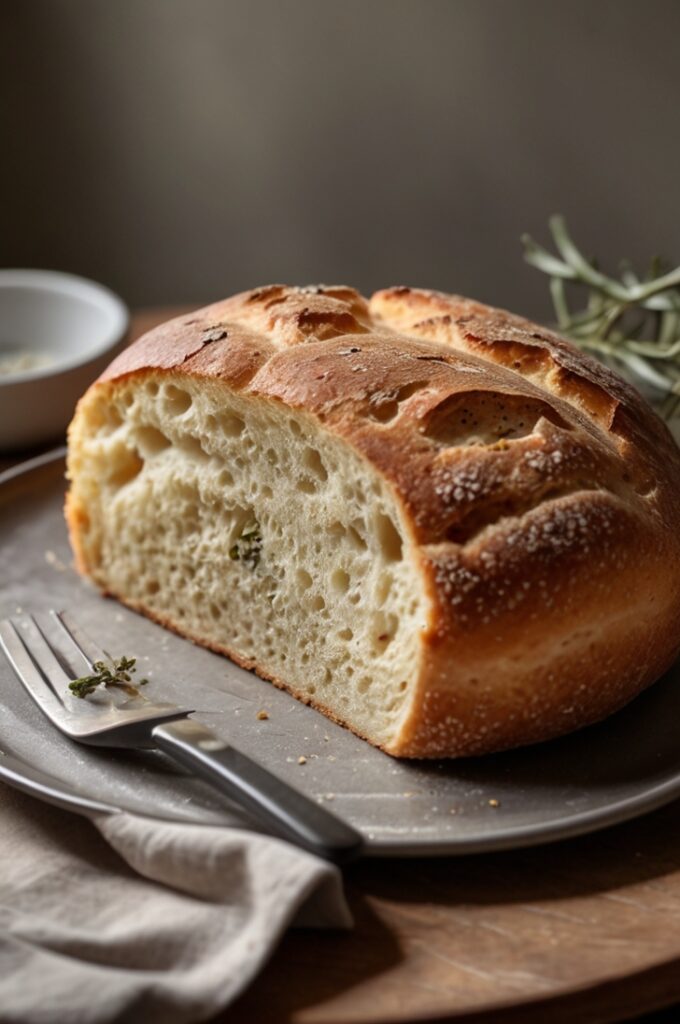I’ll never forget the first time I pressed my fingertips into a proofed focaccia dough. Ultimate Homemade Focaccia Bread Recipe doesn’t even begin to cover what it felt like.
It was like sinking into a memory foam mattress that had been blessed by the bread gods. Warm. Puffy. A little sticky. And the smell like olive oil and childhood and something new all at once.
Focaccia ain’t just bread. It’s character. Mood. Attitude on a tray. Puffy with pride, crusty in all the right ways, and soaked in olive oil like it knows it’s about to be devoured. What makes it magic? Technique. Fermentation. Good flour. And giving it time to be its best self.
This isn’t your rushed-weeknight-pizza-dough vibe. This is slow, intentional, fragrant bread with roots sunk deep into Italian history. Every bite should whisper Genova. Or at least shout it if you use enough sea salt.
Let’s break this masterpiece down.
Ingredients & Substitutions

Basic dough:
- 500g (about 4 cups) bread flour high-protein, strong flour makes better bubbles
- 2 tsp kosher salt fine sea salt works too, just not iodized table salt please
- 1 tsp sugar just a nudge to wake the yeast up
- 1 packet (7g) active dry yeast or instant yeast either’s fine, just hydrate active first
- 400ml lukewarm water body temp-ish, not lava
- 2 tbsp good extra virgin olive oil (plus more for drenching) use fruity stuff, not cooking-grade
For the pan & topping:
- 4–5 tbsp extra virgin olive oil again, don’t cheap out
- Flaky sea salt Maldon, if you’re feelin’ bougie
- Fresh rosemary sprigs dried will work, but fresh cracks through with more aroma
- Optional: halved cherry tomatoes, olives, caramelized onions, garlic slivers, za’atar, chili flakes
Substitutes & notes:
- Can’t do gluten? A gluten-free blend can work, but expect less chew and less rise go with a tried blend like Cup4Cup.
- No fresh herbs? Dried rosemary or thyme, but rehydrate in oil first so they don’t burn to a crisp.
- Want whole grain? Sub 25–30% whole wheat for a nuttier depth but don’t go full rustic, it’ll be dense.
- Oil-free? Sorry, friend. This is not the recipe for you. Focaccia is olive oil. Period.
Step-by-Step Instructions
Step 1: Activate the yeast (if using active dry)
Mix yeast, sugar, and a splash of the warm water in a cup. Let it sit 10 min. Frothy? She’s alive. If not, try again with fresh yeast. No bubbles = dead.
Step 2: Make the dough
Combine flour and salt in a big bowl. Add yeast (proofed or instant), pour in the water. Mix with a wooden spoon or your hand it’s a shaggy mess, that’s okay. Don’t knead it. This is a no-knead dough.
Step 3: First rise (bulk fermentation)
Drizzle olive oil over the dough and turn it to coat. Cover the bowl with plastic wrap or a damp towel. Let rise at room temp 12–18 hours. Overnight works. You want it doubled, bubbly, and loose like a belly after a big dinner.
Pro tip: Cold fermentation (fridge) for up to 24 hrs gives even deeper flavor. Do it.
Step 4: Shape & second rise
Coat a sheet tray (9×13 or even bigger) generously with olive oil. Dump the dough in don’t punch it down. Just plop it out like a blob of joy. Stretch it gently to fit the tray. It might resist. Let it rest 15 min and stretch again.
Cover and let rise 2–3 hours till it’s puffed and jiggly. Like it’s breathing. You’ll see bubbles under the surface. That’s what we want.
Step 5: Dimple & top
This is the best part. Coat your hands in oil. Use your fingers to press deep dimples into the dough. Not just pokes presses. Don’t be shy.
Now scatter rosemary, salt, whatever toppings you like. Go artistic. Channel your inner bread Van Gogh.
Step 6: Bake
Preheat oven to 450°F (230°C). Bake on the lower rack for 20–25 minutes. You want deep golden edges, maybe even a bit scorched in spots. Bottom should be crisp. Lift and peek if you’re not sure.
Common mistake: Underbaking. Don’t. Pale focaccia is sad focaccia.
Cool slightly. Or don’t. Tear it hot, with your hands, at the counter. That’s how Italians do.
Cooking Techniques & Science
Why no-knead?
We rely on time, not muscle. Long fermentation lets gluten form naturally, giving that chewy, airy interior. No kneading means fewer crumbs, fewer dishes, and more time to sip wine.
Why so much oil?
Oil coats the dough, crisps the crust, and carries flavor. It also fries the bottom slightly in the tray. That crackly base is everything. No oil = no crunch.
Fermentation matters
The slow rise isn’t just for fluff. It develops flavor. Natural yeast activity creates acids and esters that taste nutty, a little fruity, complex. Rush it and you lose that.
Dimpling technique
It’s not just for show. Dimpling prevents big air pockets from puffing unevenly. Plus, the little valleys hold oil and toppings like edible treasure.
Pan choice matters
A dark, heavy tray = crisper bottom. Thin or light pans may underbrown or warp. Cast iron skillet? Killer choice for smaller batches. Just preheat slightly and go heavy on oil.
Serving & Pairing Suggestions

Serve warm. Please. That’s when the crust sings.
Cut it into thick slabs or irregular chunks. Focaccia ain’t fussy. It’s rustic and wild.
Pair it with:
- Burrata and marinated tomatoes
- Thinly sliced prosciutto and arugula
- Roasted red pepper soup
- A glass of Chianti or crisp Sauvignon Blanc
- Or just a good olive oil and balsamic for dipping (throw in a pinch of flaky salt, too)
Want to turn it into a meal? Slice horizontally and sandwich with grilled veg and cheese. Panini press it till melty. You’ll cry a little. In a good way.
Got leftovers? Slice and toast for croutons. Or cube it and soak in tomato juice and olive oil for a rough-cut panzanella.
FAQs About Ultimate Homemade Focaccia Bread Recipe
1. Can I make focaccia ahead of time?
Yep. Let it rise in the fridge overnight, shape and bake the next day. Or bake fully, cool, and rewarm before serving 350°F for 10 minutes revives it beautifully.
2. Why is my focaccia dense or gummy?
Likely underproofed or underbaked. Let the dough fully double and get jiggly before baking. Also make sure your oven is hot enough and the bake time long enough to develop structure.
3. Can I freeze focaccia?
Absolutely. Wrap slices tightly and freeze. Reheat from frozen at 375°F for 10–12 minutes. Almost like fresh.
4. My dough stuck to the pan what happened?
Not enough oil in the pan, or wrong type of pan. Always use a heavy tray and really oil it. Think of it like frying, not baking.
5. Can I use sourdough starter instead of yeast?
You sure can. Replace the yeast with 100g active sourdough starter, adjust water to 350ml. Ferment a little longer, but flavor? Unmatched.
You’re now armed with everything you need to make the best damn focaccia of your life. Go oil those pans. Get your fingers messy. And remember if your kitchen smells like an olive grove kissed by flame, you’re doing it right.
Conclusion
Real focaccia is a love letter. To patience. To olive oil. To the power of fermentation and hands in dough.
This recipe brings professional results without a mixer, without a dough hook, without stress. It’s forgiving. Flexible. It rewards time and care with every golden, crunchy, chewy, salty bite.
If there’s one tip I’d shout from the rooftops? Don’t skimp the rise. Don’t rush the dimple. And never never hold back on the oil.
This isn’t the diet bread. This is the damn that’s good bread.




